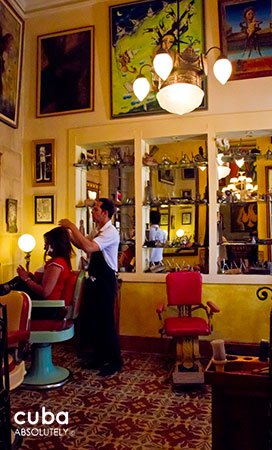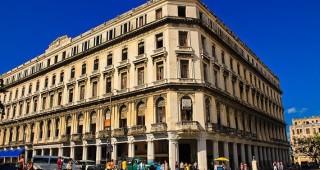
Established about eight years ago, Arte Corte is a hairdressing salon that is also an “interactive museum” where the customer, while comfortably seated in a hundred year-old chair awaiting their turn, may view antique scissors, razors, mirrors, vials, shaving brushes, combs, brushes and advertisements, along with original paintings and drawings by Cuban artists, all focusing on the topic of hairdressing.
Papito’s: The most beautiful hair salon in Cuba
By Victoria Alcalá
If you have the time (and you do need time), there is only one place to get your hair cut in Havana–that is the hair dressing salon of Gilberto Valladares (Papito) in Old Havana. While you’re there, you’ll quickly realize that this place doubles as an interactive museum to the art of hair dressing. Admire his antique scissors, razors, mirrors, vials, shaving brushes, combs, brushes and ads as well as original paintings and drawings by Cuban artists dedicated to the art of hairdressing. Once you sit in a 100-year-old chair and he starts coloring, cutting and curling, you will see just why he is considered Havana’s best hairdresser.
Loquacious like all good barbers, Gilberto Valladares (Papito) speaks at the same speed and enthusiasm as his hands handle the scissors. However, his conversation don’t involve homeruns made by his favourite baseball team or inappropriate comments about the beautiful woman who lives across the street. Neither does he attempt to captivate his clientele by talking of the merits of a new hair dye that will soon hit the market or how many litres of silicone a certain movie star has in her body. Instead, Papito talks of his projects, his most recent find for a future hairdressing museum, or a new addition to his art collection: To the Last Hair. It’s therefore hardly surprising that we should find, seated in Papito’s salon, a popular TV announcer determined to change her look or a renowned Cuban art curator waiting for a traditional haircut.
Born in Havana in 1969, Gilberto Valladares confesses that he was a restless child, easily distracted in the classroom, and not given to school work. His parents soon urged him to learn a trade, and so he chose—not with much enthusiasm at first—to become a barber.
Having completed a training course, he took his first job as a barber in the working-class Havana neighbourhood of Jesús María. Discovering that he had a real flair for the trade, he moved on to the more sophisticated salons of the capital. But becoming a top barber was not enough for the inquisitive and restless young man: he developed a passion for the history and traditions of hairdressing, which began in Cuba in 1552 when the Spaniard Juan Gómez who was deft at trimming hair, beards and moustaches, extracting teeth, treating wounds and giving bleedings received his barber’s license.
This interest in his trade led Papito to start his unusual collection of hairdressing artefacts which are exhibited at his private salon, a sort of “interactive museum” where the customer comfortably seated in a hundred-year-old chair may view antique scissors, razors, mirrors, vials, shaving brushes, combs, brushes and ads as well ash original paintings and drawings by Cuban artists on the topic of hairdressing. Papito proudly displays these paintings on the walls of his salon: Artecorte (Cutting Art). He is convinced that these pieces constitute the beginnings of what one day will become the first Hairdressing Museum in Cuba.
But Artecorte is much more than this. Since 2002, Papito’s cultural project, which has gained the support of the City Historian’s Office, has brought together barbers, hairdressers, models, artists and historians who seek to preserve and disseminate the history of hairdressing in Cuba. To this end, they organize exhibitions, shows and art festivals. Artecorte also presents the Juan Gómez Award to the most experienced and successful hair stylists and celebrates a number of events, including Barber’s and Hairdresser’s Day. This event was first begun in 1946 in honour of Cuban barber, poet, journalist and patriot Juan Evangelista Valdés Veitía (1836-1918). To celebrate this day, on 27 December 2006, a simultaneous haircutting event gathered 193 barbers and hairdressers who turned Old Havana’s Plaza Vieja into a huge outdoor salon, which also served as the perfect setting for “Habáname” (Havana-me), a hairstyle show that exhibited creative and fantasy coiffures inspired by emblematic sites and monuments of the city.
So, if hairdressing and art is the thing for you, do not hesitate to visit Papito’s museum-salon located at Aguiar No. 10 entre Peña Pobre y Avenida de las Misiones in Old Havana where he will more often than not invite you to share in his dreams and projects.
March 2010
















 Traditional Bar
Traditional Bar








